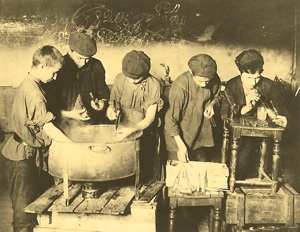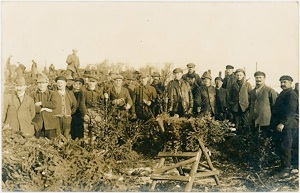From the 16th century Christmas tree decorations have been created from various materials. The most spectacular and fragile decorations are assembled of glass beads and bugles – called Gablonz ornaments (or in German Gablonzer Glasperlen-Cristbaumschmuck). They were produced in the region of Jablonec nad Nisou (or in German Gablonz an der Neiße) – capital of the Austrian bead industry during the Austrian Empire in Northern Bohemia (now Czech Republic) starting in the middle 19th century.
In the early 1800s Hans Greiner (Germany) developed a way to blow beads and silver them inside. These soon became popular all over Europe and other inventions followed. In 1845 glassmakers at Jablonec nad Nisou also began making hollow beads. 1870 Justus Liebig from the town of Morgenstern near Gablonz invented the craft of lining glass objects from the inside with silver. Many designs and innovations were introduced and the tradition of making elaborate Christmas tree ornaments developed. Silvered, polished or even gold-plated beads were strung up and bent artistically into various shapes with thin wires. In the beginning production of glass beads, hand or mouth-blown, as well as multiple strings and small glass tubes was a speciality of the jewelry industry. So, originally the fabrication of beaded Christmas ornaments from the native material was developed as a co-product of a glassmakers who produced certain designs at homes for a larger centralized trading companies. Only in the 20th century producing of Christmas decorations became a branch of its own.
Objects and ornaments of this collection were created in late 19th – first half of the 20th century. They were assembled with different types of beads: pressed beads, rocailles beads, beads with additional interior grooving, glass rods, atlas beads, wooden beads, molded blown beads or hollow beads with silver or gold lining in countless variations of color, patterns and transparency. Older Gablonz decorations are including small disks or cubes of golden composition material, which hold the wires of onament together. Some objects excitingly combining with beads other different materials: tinsel, cotton spun, lametta, chenille, foil, phosphoric wax, wire etc. Some objects, for example bicycles or tea cups, including glass rings, which where produced from about 1850`s in the same area. At first these rings where produced as napkin rings. Later they found there was a large market in India for bracelets and refined many manufacturing methods because of this. Lamp-worked bangles made with patterned canes were first made about 1908. The makers of the upper Neisse Valley created different types of overlaid glass including stripes. The threefold bangles where press molded which was further refined by cutting and polishing. Each one of these glass rings is an amazing little piece of artwork in glass. Wonderful twisted striped and plain canes wound into rings press molded and plain. Some rings may have cracks and some rings and not completely closed welded at joint...
I did not include in this collection Russian and Japan beaded ornaments, which are distinctly differ from created in Bohemia.
Enormous variety of individual ornaments published at this site includes figurative pieces divided in three groups: everyday objects, animalistic and transportation pieces as well as geometrical and abstract designs, – all created with vivid imagination and extremely high degree of artistic sophistication.
Enjoy!




